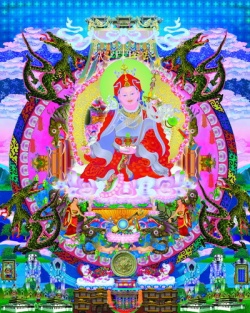The Two Truths - The Transcendent Absolute (Nonduality) and Phenomena
1. The Absolute and the Relative Reality
The Nondual Absolute Reality in Itself - Shunyata, Paramatman, Tao, Buddha-nature, etc - is the Supreme Ground of all Reality.
Its attainment is experienced as Nirvana or Liberation or or Self-Realization.
The opposite of this state is the world of phenomena, Maya, the relative truth, Illusion, Samsara, "the wheel of rebirth", subject to Ignorance (avidya) of one's True Nature, craving, unhappiness, and so on.
It is generally considered that between these two extremes there is no continuum, unlike the other dimension/parameters we have considered.
The lower, relative reality, is a juxtoposition on the higher, the Absolute Reality.
That's why the various Indian philosophies (Vedanta, Mahayana, etc) speak of the "Two Truths", the Relative and the Absolute Truth.
Hence Enlightenment (realisation of the Absolute) is not something to be attained, because one always was and is the Absolute.
Enlightenment is simply the realisation that you are the Absolute right now, and that there is no birth or death, future or past, self or other, but only the eternal present, the one universal "I" (this is putting it very simply, but space does not allow an analysis of the subtlties of the doctrine, or the differences between Mahayana Buddhist and Advaita Vedantin conceptions of Enlightenment).
2. Three Grades of Knowledge
Yet from another point of view one can suggest a continuum, in the area of Advaitin and Mahayanist epistemology (science of knowledge).
Whereas Western academic epistemology is divided between the Rationalists, who say we know things because our minds contain pre-existent ideas, and the Empiricists, who say that the mind is a blank slate, and everything we know and learn is through the senses, the Indian mystical epistemology is concerned with spiritual knowledge, rather than knowledge about (general or mundane) knowledge.
Basically, this monistic philosophy (both Advaita and Mahayana affirm a single Absolute Reality) refers to three grades of knowing, each lower of which is false in relation to the next.
The highest level is transcendental knowledge
The lowest grade is illusion, or hallucination, such as things in a dream, which appear real while dreaming, but then are seen to be false upon awakening; or tricks of the eye, such a rope which in the distance or in the dark appears to be a snake, or mother-of-pearl which appears to be silver.
The next level is "empirical knowledge; knowledge as it appears to the senses (and, one may add, to the instruments of modern science), and which reveals the world as it "objectively" is.
The highest level is transcendental knowledge; knowledge of Reality as it actually is, revealed through the super-conscious or enlightenment experience.
Relative to this absolute knowledge, everyday empirical knowledge stands in the same relation as hallucination or misperception stands to the latter.
is, the objective world itself is realised to be a "dream", an "illusion", a "rope-snake", or whatever.
Realisation of absolute knowledge is the same as realisation of the Absolute (or Godhead) itself, because in these spiritual traditions the Absolute is itself considered as a - or rather the - faculty of knowing or experience; or in other words of the nature of pure Consciousness.
The terms of the three grades of knowledge vary according to the particular school of thought.
To give three examples
| Nagarjuna 2nd C Buddhist |
Vasubandha 3rd C Buddhist |
Shankara 8th C Vedanta | |
| 3. Absolute | Paramartha | Paramarthika | Paramarthika |
| 2. Empirical | Samvriti | Paratantra | Vyavaharika |
| 1. Illusion | Samvriti | Parikalpita | Pratibhasika |
An interesting twist to this is given in Tibetan Buddhism, where there is the distinction between the lower Enlightenment of the Dharmakaya (Truth-dimension) and the greater Enlightenment of the Swabhavakaya (Self-nature dimension).
This theme is adapted by Da Free John, who distinguishes between subjective Enlightenment (realisation of the Self or Absolute Within), and objective Enlightenment (realisation of the Absolute - the Radiant Transcendental Being - in all things.
Hence we could say that the Paramartha or Absolute Truth is divided into a lesser and a greater.
And when we consider that even someone of the calibre of Da Free John himself fell into narcissism in the end, claiming to be the only true Realiser of all time (relegating Ramana, Siddharta, and others to a lesser status), it seems that even this objective Enlightenment can be divided into a lower or "Intermediate Zone" and a higher or Complete Realisation stage.
Complete Paramartha
Hence:
Complete Paramartha / Realisation: = Absolute Realised in all things, total transparency to the Supreme
Higher Paramartha: = Absolute Realised in all things, but still with element of ego
Lower Paramartha: = Absolute Realised within; Liberation
Paratantra/Vyavaharika: = Relative Knowledge
Parikalpta/Pratibhasika= Illusion
3. The Way of Form and the Way of Formlessness
All this is explaining things from a pure "Knowledge Yoga" perspective, but there are also other teachings - Tibetan Buddhism and Taoist Yoga to name just two - which strive for realization of the Absolute through other dimensions of being, such as the Inner or etheric-psychic-occult.
It all depends whether one prefers the austere approach or the way of form.
A good example of the way of form is shown by Tibetan Buddhism, in which painstakingly elaborate visualisation (Mental body), including visualisation of chakras (Etheric body), deities, mandalas, etc, is combined with focused meditation (inner mental being) to contact and identify with particular deities (expanded/shuddhas huddha being) and activate the subtle "winds" (vayu = prana = ch'i) (inner etheric body).
This finally generates first an "impure illusory body" (Inner Etheric and Inner Astral; Lower Paramartha) and finally a "pure illusory body" (Higher Paramartha), which latter represents the attainment of full Buddhahood.
In contrast to all this is the austere but much simpler and presumably easier to follow techniques of Advaita Vedanta, which attempts to realize the Absolute through a continual intuitive-mental approach of focusing on awareness (see for example the teachings of Ramana Maharshi).
The Rinzai Zen attempt to break down the mental structure through the constant pondering on a paradoxical utterance or koan is somewhat similar, although employing a novel approach.


